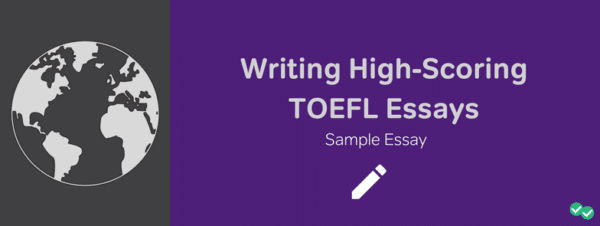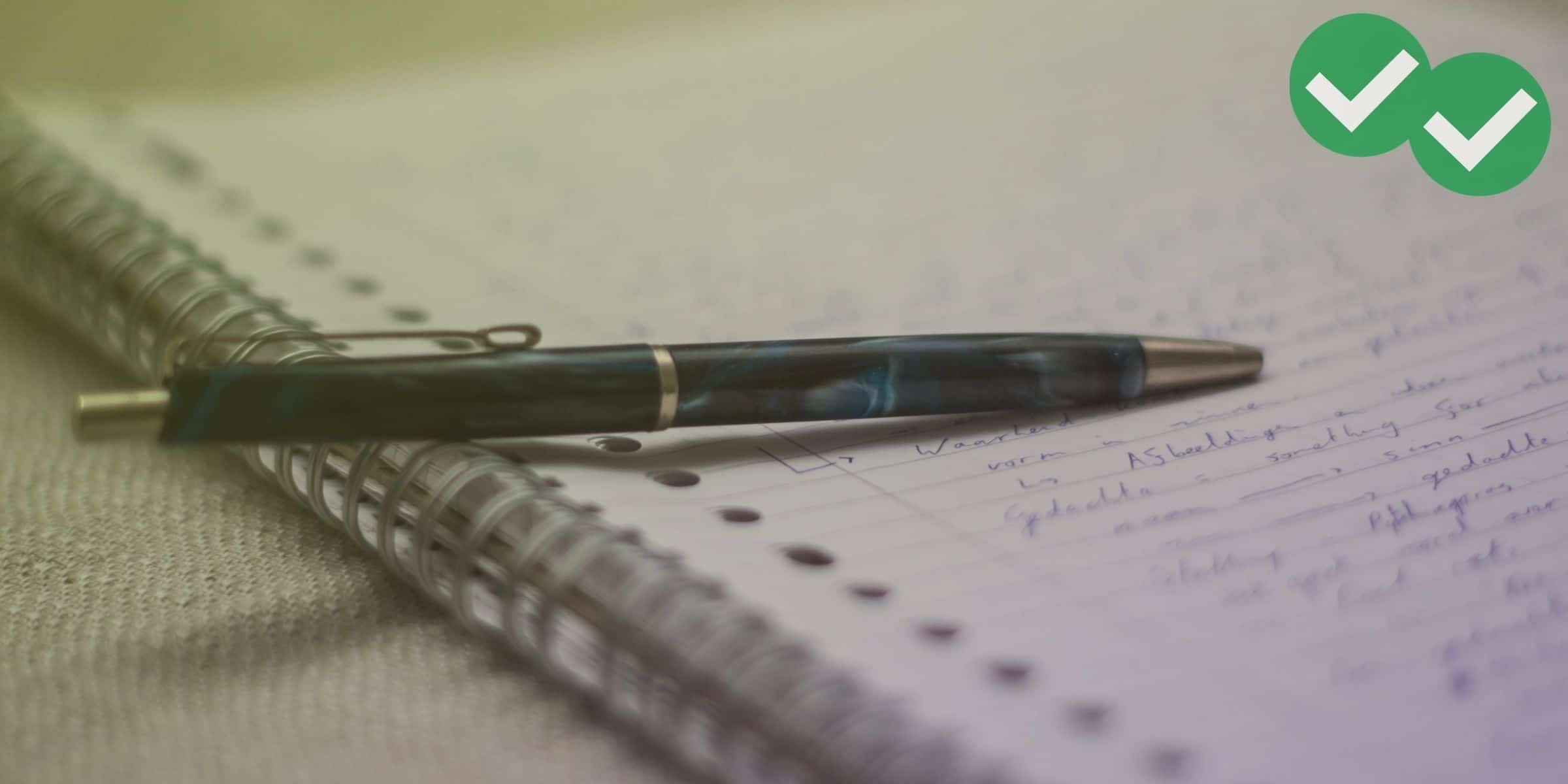
One of the hardest sections to prep for on the TOEFL can be the TOEFL Writing section. After all, it’s hard to find a native English speaker who will correct and grade your essays in the writing section—and even harder to find one who knows the test! Never fear. In this post, we’ll look at sample high-scoring essays for the first and second tasks and then break down what’s good about them (and how they might improve!)
In this post, I’ll also provide links to several additional TOEFL Writing samples for the Independent Writing task. And there will be two TOEFL Writing samples for the Integrated Writing Task. These sample answers will come with full Writing Task 1 essay questions. Like the Integrated Writing questions on the real TOEFL test, the prompts in this post will include a reading passage and an audio recording of part of a lecture.
Table of Contents
- TOEFL Writing Task 2 Basics
- Model TOEFL Writing Task 2 Essay (Independent)
- Additional TOEFL Task 2 Writing Samples (Independent)
- Introduction to TOEFL Writing Task 1
- A Sample TOEFL Integrated Writing Task, with Model Answer
- Where to Find Other TOEFL Integrated (Task 1) Writing Samples
- TOEFL Writing Samples: The Takeaway
Starting at the End: Writing Task 2 Model Essays
I’m starting with the second task on the Writing section of the TOEFL exam. Why you may ask? Well, the hypothetical reader that I’m having a conversation with, I’m starting with TOEFL Writing Task 2 by popular demand. Magoosh gets far more requests for Task 2 help than requests for help with Integrated questions. But if you are here for TOEFL Writing Task 1, don’t worry– we’ll get to that first task right after this section on the independent questions.
A Few Quick Tips on Using These TOEFL Writing Task 2 Samples
Remember that TOEFL Writing Task 2 requires you to give a personal opinion on a broad social issue. The TOEFL Writing topics covered in task 2 will likely be ones you’re already familiar with: issues related to things like high school, life in a small town vs. a big city, how governments should support education, dealing with co-workers, etc…. Be prepared for contemporary topics about today’s world as well: social media, cell phones, technological advances, and the like.
Above all, be prepared to share your personal experiences, while still following the rules of formal academic writing. An effective response is personal in nature, but academic in tone and structure. Give a main reason for your opinion, but also use reasons– well thought-out ones– to support that opinion. Use the Task 2 TOEFL Writing samples shown and linked below below to build your own writing skills and write your own TOEFL essays.

A Model TOEFL Writing Task 2 Essay, With Commentary
CLICK TO EXPAND
If you’re doing your own practice, I suggest attempting to answer the prompt yourself under timed conditions; then, compare your essay to the sample essay. As you make that comparison, you can look at the section of the post below the sample essay, in which we break down why this essay works! For our prompts, we’ll be looking at some of Kate’s excellent suggestions in this post on TOEFL writing. Let’s give it a go with the first independent essay topic!
Prompt
- Do you agree or disagree with the following statement?
Modern life is easier than life in the past.
Use specific details and examples to support your answer.
Sample Essay
I definitely agree that modern life is easier than life in the past. The increased use of technology, rising standards of living, and improved healthcare have combined to make our lifestyles, at least in the first world, luxurious compared to lifestyles of the past. By examining three specific examples—personal computers, The Lion in Winter, and vaccines—this essay will demonstrate that this improvement has, indeed, taken place.
In the first place, technological advances have created new ways to take care of mundane tasks quickly and easily. For example, the majority of Americans now have their own personal computers. This is an amazing advance: with computers, we can complete tasks, from banking to ordering groceries, that would have taken hours even a few decades ago. Word processing is common, making the spread of information much easier to achieve, and education is available to all for free through online courses and information that would have been all but unattainable for many up until the end of the twentieth century. The sheer amount of access that we have to services and knowledge through these machines has made life extraordinarily easier.
Secondly, our standard of life has changed through advances in engineering, architecture, travel, and even textiles. Looking at a film like The Lion in Winter, while by no means historically perfect, does show how even everyday things were more difficult almost a thousand years ago. Set in the 1100s, the film shows King Henry II having to break ice from his water bowl to get water to wash his face—something that hot and cold running taps have long since saved us from. The queen has to travel to see her husband by a long boat journey, which would be almost unthinkable today. Finally, the entire royal family, even though they are royal, is wrapped in encumbering furs. Looking at what was once the highest standard of living, compared to the average first world standard of living today, we can see how much easier progress has made our lives.
Finally, we no longer live in fear of many common diseases that once crippled or maimed large populations, making their lives much harder. For example, polio used to strike many people, in some cases making it difficult for them to walk, such as Franklin D. Roosevelt, who used a wheelchair. The invention of that vaccine in the 1950s, as well as numerous other vaccines, has created a situation in which we no longer have to suffer unnecessarily. This is most certainly an improvement over the past.
In conclusion, life today is definitely easier than life in the past. Though it is easy to read stories of nobles and kings of history and romanticize them, their lives were almost certainly more uncomfortable than our lives are. Nevertheless, there are many places in the world where laptops, modern conveniences, and vaccines are rarely found; I hope that current generations will work together to make life easier for everyone, now that it is possible to do so.
Essay Evaluation
OK, let’s dissect this sample essay. Specifically, we’ll be taking a look at what the author did well and points upon which the author could have improved.
Now, let’s go through a few important points. First of all, remember that the TOEFL essay is scored holistically, meaning that you don’t get a certain number of points off your score (or added on) for the absence or presence of different items. Rather, the scorers grade it against a rubric, seeing which points from the rubric best describe your essay.
First of all, a thesis statement: we want this to be immediate and direct. By immediate, I mean that it should show up within the first few sentences of your essay. Here, the author does this: right away, she writes “I definitely agree that modern life is easier than life in the past.” Remember, we don’t have to be terribly nuanced about this. Sure, you can argue that it’s easier in some ways and harder in others—but you’ll have an easier time just taking one position and sticking to it, as you don’t have a huge amount of time to write this essay! It might be a prettier essay if this author eased into the subject by providing an example or a quote to start with, but this works pretty well in the introduction.
Which leads us to another point…an introduction and a conclusion. This author has them! They’re pretty brief—given more time, it would be nice to have a quick recap of the points she’s made here, but they do exist. This makes the structure easier to understand and helps the scorers to see right away that you understood the task and have addressed it, fully and completely.
Next, the examples. These are of primary importance! The examples here are relatively simple, but we don’t need to reinvent the wheel (so to speak). Notice that this author picks examples from different areas: society, a movie, and history. The FDR example could maybe be fleshed out a little more and elaborated on to make this more specific and slightly stronger, but generally, these examples do make the author’s point.
What about the language? It’s pretty strong here. The author varies her sentence structure; take a look at the conclusion for an example of this. She uses transition words (“in conclusion”), although these are sometimes simple. Finally, she also shows off her vocabulary (“encumbering,” “romanticize”), demonstrating that she has an advanced grasp of English.
Is this a perfect essay? Not by a long shot. But is it a high-scoring TOEFL essay? You bet.
What do you think? Share your thoughts in the comments below! (And for a look at supporting your claims in TOEFL Writing, based on the same TOEFL Writing Task 2 topic as the one above, check out TOEFL Independent Writing Tips: Support Your Claims.)
Additional Task 2 TOEFL Writing Samples
On our blog, we have quite a few other TOEFL Writing samples for the Independent Task. Here’s a roundup of additional models you can look to as you refine your TOEFL Writing skills for the second task and aim for a high score.
- TOEFL Writing Task 2 Question With Model Answer Here, David shows you a TOEFL iBT practice prompt, and a model answer. Then, he breaks down the grammar features of the answer and shows how a good model answer can be revised and made even better with greater grammar variety. Since there is a revised version of the initial response, this post really contains two TOEFL Writing samples.
- TOEFL Writing Task 2: Model Brainstorm, Model Outline, Model Essay This model essay includes examples of how to do prewriting: taking good notes for a good essay. You’ll learn how to brainstorm possible main ideas regarding your opinion on a particular topic. You’ll then learn to narrow down that brainstorming and create an outline that highlights your main point and your supporting key points. Finally, you’ll see how to take the specific points from your outline
- TOEFL Independent Writing: Correcting Disorganized Answers Our blog also offers flawed TOEFL Writing samples like this one. Here you can read a Writing Task 2 model answer that’s a little disorganized, and then complete some activities where you revise and improve the essay yourself.
- TOEFL Independent Essay Mistake: Unsupported Claims Here we have two flawed TOEFL Writing samples that fail to fully support their claims. Each essay is followed by advice on how to improve.
- TOEFL Independent Writing: Examples of Counter-Arguments This article actually contains five different TOEFL Writing samples for Task 1. Each model essay is a slight variation on the others, showing different ways that test-takers can handle counter-arguments in TOEFL Writing Task 2
- TOEFL Writing Task 2: How to Use Transitions in Your WritingTo be clear, this link contains zero complete TOEFL Writing samples. However, it does include a model introductory paragraph to a TOEFL Writing Task 2 essay, along with a tutorial on the use of transitions in Independent Writing.
- Magoosh’s TOEFL Writing Templates This guide also focuses on partial TOEFL Writing samples, although it does also have some complete model essays. Our templates give you example transitions, phrases, and other structures that you can memorize and apply to top-scoring TOEFL essays.
Introduction to TOEFL Writing Task 1
TOEFL Integrated Writing prompts can be challenging tasks! In this first part of the TOEFL iBT Writing section, you need to do the following:
- Read a short passage.
- Listen to an audio clip that featues a short lecture related to the passage.
- Summarize the main points of the audio clip as they relate to the key ideas in the passage.
As you can see, this TOEFL Writing essay type is complex, with multiple parts. But have no fear. Magoosh offers sample questions and sample responses for this task as well. We’ll start with the task below, which is taken directly from our premium TOEFL prep service. (The sample essay and answer explanation also come from our premium service!)
A Model TOEFL Integrated Writing Task, With Full Sample Prompt and Commentary
CLICK TO EXPAND
Read the following passage and continue.
American literature of the early 20th century saw the rise of a number of influential authors writing in a new style. Ernest Hemingway, F. Scott Fitzgerald, E.E. Cummings, and Ezra Pound, among many others, left an undeniably deep impact on how we write, even today. The author and poet Gertrude Stein is sometimes included in such lists, but her work is notably less influential than that of her contemporaries. For a number of reasons, critics have often pinned her work as an eccentricity worthy of little more than a historical footnote.
For one, Stein’s works tend to be inaccessible to the reader, primarily because she did not clearly communicate thoughts and emotions in much of her writing. Literary critic Edmund Wilson asserted that Stein’s shortcoming was that she took many of the concepts that underlay Cubism, a style of painting that emphasized visual representation without clear emotion or meaning, and attempted to apply them to language. This resulted in work that relied heavily on the sounds of the words used, rather than on the meanings they held.
Moreover, Stein’s work rarely included conventional punctuation. Her sentences blend together into long, unbroken chains, without commas or periods to signal where one idea ends and another begins. In avoiding punctuation so often, Stein made her prose and poetry unnecessarily difficult to decipher. Few authors have avoided punctuation in the same way because it simply distracts from the writer’s message and adds little value if any.
Certainly, it is easy to be deceived as to Stein’s literary influence by the historical importance of Stein’s salon—regular gatherings in her home frequented by a number of renowned artists. However, in studies of American literature, the work produced by a figure is far more valuable than are their social connections. Although Stein was close with several major authors and artists of the time, that fact alone does not give her real historical significance.
Now, listen to the lecture.
Click here to listen.
Once you’ve listened, summarize the points made in the lecture you just heard, explaining how they oppose specific points made in the reading.
TOEFL Independent Writing Task 1 Sample Essay
The professor giving the lecture on Stein disagrees wholeheartedly with the views presented in the text that her class had read. There are a few key points that she calls specifically into question: how well Stein communicated, the refusal to use punctuation, and the importance of Stein’s social connections.
In the first of those three points, the professor presents an argument that contrasts starkly with the text. Whereas the reading says that Stein’s use of cubist aesthetics created inaccessible work—prose that did not communicate to the reader—the professor brings up the possibility of Stein’s impact on later poets. She argues that since Stein’s day, poetry has shifted to rely more heavily on the sounds of words used, rather than their meaning, and that Stein was likely a significant influence on that change.
Furthermore, according to the professor, Stein’s decision to omit punctuation from her work was not merely a way to make her writing more difficult to follow. Instead, Stein elaborates in her own essay on the topic on why she viewed punctuation as unnecessary. The professor is of the opinion that Stein’s view is both valid and unique, one that we should contemplate carefully.
And finally, in her lecture, the professor points out that Stein’s influence on the writers and artists she kept as friends is not to be understated as merely a social connection. Although the text claims that Stein’s “salon” was only of historical significance, rather than literary importance, the speaker says that Stein directly affected the writing style of Hemingway. That provides clear evidence of Stein’s importance in the development of literature at the time.
Explanation of the Sample Essay Above
Where to Find Other TOEFL Writing Samples for TOEFL Integrated Writing
As you’ve seen, TOEFL Integrated Writing tasks include a passage and an audio lecture. Because of this, free TOEFL prompts and TOEFL Writing samples for this task are a bit less common, compared to TOEFL Writing samples for the second writing task.
Still, there are a number of places you can go for free or affordable model essays for the first task in the TOEFL Writing section.
Let’s start with the other free TOEFL Integrated Writing task you can find right here on the blog: the model prompt and essay (with commentary) found in Magoosh’s complete guide to TOEFL Integrated Writing. The model essay there comes with two additional companion posts: a tutorial on paraphrasing in TOEFL Integrated Writing, and a guide to revising your work in TOEFL Writing Task 1.
Next, let’s look at free TOEFL Writing samples for Task 1 from the most authentic source out there: ETS, the official makers of the TOEFL Exam. ETS includes free Integrated TOEFL Writing samples in their online TOEFL Writing practice sets. And on TOEFL TV, ETS’s YouTube channel for the exam, there is a video tutorial that includes a model Integrated Writing essay.
Note that neither of the two resources above contain complete prompts. The practice sets have transcripts of the lectures, but no audio. And unforntuately, the TOEFL TV video contains only partial audio from the lecture, and no transcript. The good news, however, is that you can find full prompts and full TOEFL Writing samples for Task 1, complete with scorer commentary, in two other ETS resources: The Official Guide to the TOEFL, and Official TOEFL iBT Tests Volume 2. These resources are not free, but they are available in the ETS TOEFL online store at very afforable prices, either in print or as downloadable eBooks.
TOEFL Writing Samples: The Takeaway
As you can see, a variety of high-quality TOEFL Writing samples are available, both from Magoosh and ETS. These model essays can help you understand what to do and what to avoid as you aim for your own top scoring essays.
And again, the very best sample essays come from ETS, as seen in the Official Guide to the TOEFL, volume two of Official TOEFL iBT Tests, and the other official TOEFL Writing prep materials. For links to those materials and other resources that can help you aim for a good TOEFL Writing score, see the TOEFL Writing Scores section of Magoosh’s free guide, “Let’s Tackle the TOEFL.”
And of course, for a free TOEFL Writing practice test, you can use the prompts from the TOEFL Writing samples in this post. In fact, with two sample prompts for Task 1 and several sample prompts for Task 2, you have two free TOEFL Writing practice tests just from this article.
Want more? Consider a subscription to Magoosh TOEFL. You can even start out with a free trial before you make your final decision, withour even having to enter any payment information.
Above all, remember that TOEFL essays are designed to measure your ability to do real college coursework in countries like the United States. So it helps to review actual college writing as well. To help you with this, we’ve compiled a list of places to find actual university-level essays from real students.
I hope all of this has been useful. Feel free to ask me any questions you have. Just leave a comment!






Leave a Reply